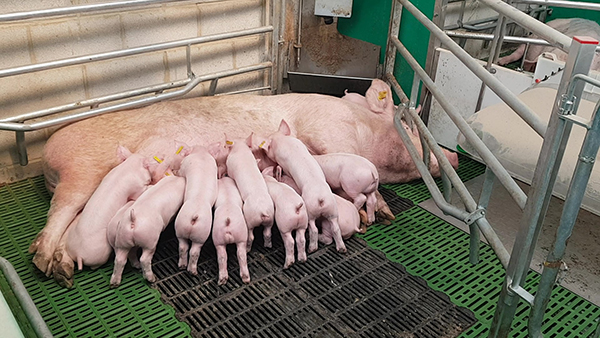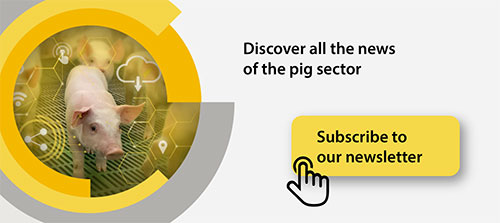Blog
Blog

How can we prevent heat stress in pigs during the summer?
12th June 2025 - News
Ensuring the welfare of pigs during the hottest months of the year is one of the challenges farmers face every year. Having well-prepared facilities, good ventilation, and good handling of the animals are key aspects to protect the animals and maintain production efficiency. Joan Escobet, a specialist in environmental control, analyses the main factors of heat stress in pigs and proposes solutions to mitigate its effects.

Joan Escobet, environmental control specialist. Photo: Joan Escobet.
What are the main factors contributing to heat stress in pigs during the summer months?
In my experience, there are four key factors. The first is the climate, which is increasingly warm and intense in Spain, with an increase in hot days, tropical nights and projections that mean a continuous rise in temperatures. The second factor is genetics. Although genetic differences exist, most are very productive under thermoneutral conditions but sensitive to heat stress. In the last five years, sow losses in summer have increased a lot for this reason. The third factor is the facilities, which have not evolved at the pace of current needs, especially regarding air conditioning and control of the animal's thermal environment—finally, the handling. A design may be adequate, but if ventilation and cooling are not managed correctly in summer due to a lack of information and training, very adverse environments can be generated for animals.
What differences exist in the response to heat stress between the different stages of pork production?
The response to heat stress varies depending on the pig's production stage. To explain this, it is key to understand the concept of "comfort zone", the thermal range where the pig has a minimum thermoregulatory effort, and its performance is maximum. In lactating piglets, this zone is between 24 °C and 35 °C; in weaning piglets, between 22 °C and 30 °C; in fattening pigs, between 20 °C and 24 °C; in lactating sows, between 18 °C and 22 °C; and gestation between 18 °C and 24 °C. However, this area is dynamic because environmental factors (such as humidity or airspeed) and factors specific to the animal (such as weight or genetics) are not considered. In this sense, the most sensitive animals to heat require lower temperatures under conditions of thermoneutrality, for example, pregnant sows in the final phase, sows in peripartum and pigs in final fattening. Piglets, on the other hand, are less sensitive to heat because their comfort temperature is higher.
How does heat affect pig behaviour and welfare?
They reduce metabolic heat by stopping eating and increasing heat loss by panting at high temperatures. The pig is balanced in the thermal comfort zone: its body temperature is around 39 °C, and its respiratory rate ranges from 20 to 30 breaths/minute, depending on weight and type. When the critical evaporative temperature is reached, panting begins, with frequencies of 50 to 60 breaths per minute. This is where heat stress begins: its body temperature rises slightly, the pig becomes inactive, eats less, drinks more, and seeks to get wet or dirty to lose heat. Corrective measures, such as ventilation or cooling, should be initiated to prevent pigs from reaching the upper critical temperature. At that stage, they already have clear heat stress, their breathing rate exceeds 100 breaths/minute, and their body temperature increases significantly. If action is not taken in time, the pig collapses due to hyperthermia, reaches more than 43 °C, and dies, as it loses the ability to thermoregulate.
And how does it affect production?
The most dramatic effect of heat stress on production is the death of pigs. In gilts, it usually causes a decrease in fertility, and the size of the litter is reduced. It can also manifest in delayed puberty, poor expression of heat, prolonged weaning-heat intervals, anestrus, return to regular or irregular heat, miscarriages, etc. In maternity, the critical point is the hours before and during childbirth. Subsequently, if the management is adequate, the risk is reduced. Heat stress can also affect voluntary feed intake, directly affecting milk production, which causes body weight loss and hinders hormonal activity initiation after weaning. Fattening pigs also have some casualties in the final phase, but it depends on genetics and health status. The average daily profit is reduced, the conversion rate increases, and the carcass quality worsens. In weaned piglets, it affects them less, with reduced intake and decreased growth, but also, it is the phase in which the animals are less sensitive to heat.

Piglets are less sensitive to heat because their comfort temperature is higher. Photo: Rotecna.
Which physiological or behavioural indicators are most reliable for detecting heat stress in pigs?
The most suitable one is to use the heat index, which combines the temperature and humidity of the air. But above all, the behaviour of pigs must be observed and assessed. The best indicator of heat stress is pigs' panting to lose temperature through respiratory methods. When the respiratory rate is between 50 and 60 breaths/minute, corresponding to the critical evaporative temperature, we must quickly return the pig to its initial comfort. In this phase, the internal body temperature (>39 °C) and skin temperature (>35 °C) also slightly increase due to increased blood flow to the body surface. Regarding behaviour, pigs are inactive, avoid contact with each other, lie in maximum contact with the ground to lose heat by conduction, reduce feed consumption, increase water consumption, and get wet or dirty to promote evaporation and thus cool down.
What management measures do you recommend to mitigate heat stress in pig farms?
On the one hand, we must minimise heat gains in the building and, on the other, maximise ventilation and cooling techniques. Heat stress occurs when the pig receives more heat from its environment than it removes from its body. The objective is to achieve a positive relationship between the pig and its thermal environment. So, to minimise heat transfer from the environment to the pig, passive building design strategies must be applied, i.e., thermal insulation, airtightness, and considering the solar orientation of the building and the presence of shading systems. At the same time, heat dissipation from the pig to the environment must be favoured through the appropriate design and management of ventilation and cooling systems. A key element is the selection of proper fans to meet maximum ventilation needs and the correct air intake adjustment. On the other hand, it is necessary to maximise heat transfer from the pig to the environment through the correct design and management of the ventilation and cooling system. In other words, we must choose the right fans to obtain maximum ventilation. Air inlets should be designed and adjusted to regulate maximum flow rate, ventilation pattern, and static pressure simultaneously. Cooling panels must have high performance at all times, and all equipment associated with ventilation must be in perfect condition, especially in summer.
How does the design of the facilities influence the susceptibility to thermal stress?
There are many parameters to assess the general design of the installation and its influence on the incidence of thermal stress in summer. A fundamental one is the volume available per animal, which is necessary to dilute heat and pollutants such as gases and humidity. Between 15-18 m³/sow in farrowing, 11-13 m³/sow in gestation and 3-5 m³/pig in fattening are recommended, with variations according to genetics, geographical area and weight. Ventilation in summer should not exceed 40 air changes per hour to ensure effective control of temperature, air circulation and efficiency of cooling systems. The arrangement of the fans and air inlets is also essential for the correct circulation of air through the room in summer with high ventilation. Evaporative cooling panels must have a high saturation capacity to cool the air and a reduced pressure drop to avoid flow losses when ventilation is at its maximum. In addition, any obstacle in the airflow, such as beams, dispensers, tubes or similar, that may hinder ventilation should be avoided.
What role do ventilation and relative humidity play in controlling heat stress?
Ventilation and relative humidity are key factors in controlling heat stress in pigs, especially in hot climates. Pigs dissipate heat primarily by evaporation by panting, which generates large amounts of water vapour. For example, a 200 kg lactating sow with an air temperature of 30°C can release about 325 g/h of water vapour. This moisture, if not adequately removed through efficient ventilation, builds up and hinders the loss of body heat, intensifying heat stress. Using evaporative cooling systems in conditions of high outdoor humidity can be counterproductive, as they hardly reduce the temperature and raise the indoor humidity even more. This increases the effective temperature perceived by pigs, reaching 39 °C to 30 °C with 85% relative humidity. Under these conditions, animals cannot dissipate heat through the respiratory tract, leading to hyperthermia and even death. In addition, the heat increases the production of CO₂ by pigs due to increased respiratory rate, which must also be evacuated. Therefore, proper ventilation not only regulates temperature and humidity but is vital to prevent gas buildup and ensure the well-being and survival of animals.

Sensors help detect heat stress. Photo: Rotecna.
What technologies are most effective for monitoring and controlling farm heat stress?
The first step in managing heat stress on farms is to properly train staff so they can identify pig behaviour and know when to act. If necessary, the technology helps monitor and act directly on the air conditioning system. The objective is to measure as close to the average of the house in the area occupied by the animals; therefore, we must distribute the sensors strategically. Using probes inside and outside the housing is sufficient to control heat stress in summer. The heat index analysis must be conducted using appropriate software that allows decisions to be made quickly without being physically present. The success of these systems will depend on the ability to adjust to the reality of the farm environment using quality sensors appropriately placed to ensure representative measurements. Regular inspection and calibration of the sensors are also essential. Still, the most important thing is to use the information for the welfare of the pigs and make production more profitable. Technologies are also being developed to monitor pig comfort, such as cameras to detect behaviour and activity, microphones to evaluate stress-related sounds, temperature microchips in the pig's skin, or remotely using infrared camera vision. However, the information generated must be analysed and categorised to make quick decisions. At this time, the role of artificial intelligence is already very relevant when making fast decisions to improve well-being.
What recommendations would you give farm managers to deal with extreme heat waves?
The main recommendation is to fine-tune the air conditioning installation in spring to have it in perfect condition for summer. We cannot change the climate but reduce or minimise its effect with a ventilation system adapted to our hot conditions. The ventilation system must guarantee both the necessary flow and a good quality of ventilation, ensuring the correct air circulation to eliminate heat and humidity. Therefore, it is essential to carry out preventive maintenance on air inlets, fans, and annexes during April. It is also recommended that the design of the building be reviewed to protect the pigs from the heat and improve the indoor environment. This includes improving thermal insulation and airtightness for efficient cooling, offering higher usable volume per pig and, if necessary, reducing animal density. It is advisable to use recirculating fans to prevent heat and gas buildup and to initially activate cooling with dry air, which reduces wind chill by 4°C to 6°C by convection. When the air temperature exceeds that of the pig's skin, evaporative cooling must be activated, directing the air to the air area to promote evaporation and reduce the air temperature. This process of wetting the panel must be progressive. It is recommended to use only dry air at night and during the day if the indoor relative humidity exceeds 80%. For a cooling system to perform well, the water must be as soft as possible; therefore, we need a water softener that reduces mineral scale. Finally, we must thoroughly clean the additional components (filters, tanks, perforated pipe, collection channel, etc.).








